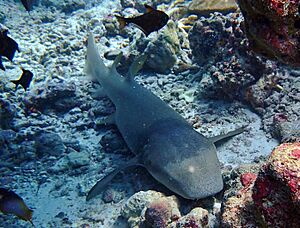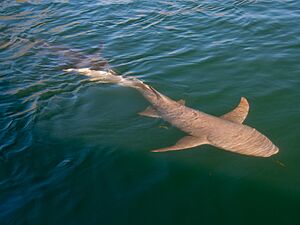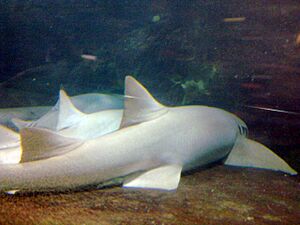Tawny nurse shark facts for kids
Quick facts for kids Tawny nurse shark |
|
|---|---|
 |
|
| Conservation status | |
| Scientific classification | |
| Genus: |
Nebrius
|
| Species: |
ferrugineus
|
 |
|
| Range of the tawny nurse shark | |
| Synonyms | |
|
Ginglymostoma muelleri Günther, 1870 |
|
The tawny nurse shark (Nebrius ferrugineus) is a type of carpet shark. It is the only living member of its group, called Nebrius.
You can find this shark in many coastal areas of the Indo-Pacific region. It likes to live near reefs, sandy flats, and seagrass beds. It lives in both very shallow water and deeper areas, up to 70 meters (230 feet) deep.
The tawny nurse shark has a body shaped like a cylinder and a wide, flat head. It looks a lot like the nurse shark found in the Atlantic Ocean. But you can tell them apart! The tawny nurse shark has pointed dorsal fins (on its back) and narrow, curved pectoral fins (on its sides). The biggest tawny nurse shark ever recorded was 3.2 meters (10.5 feet) long.
These sharks are active at night. During the day, they often rest in groups of 20 or more. They pile up inside caves or under rocky ledges. At night, they become active hunters. They use a powerful suction force to pull their food out of holes and cracks. Their favorite food is octopus, but they also eat other small sea creatures like crabs and squid. They sometimes eat small bony fishes and even sea snakes.
Tawny nurse sharks give birth to live young. The baby sharks hatch from egg capsules inside the mother's body. These sharks are unique among carpet sharks because their embryos eat eggs produced by the mother while still inside her. A mother shark might have only one or two babies at a time.
Compared to other nurse sharks, the tawny nurse shark is usually calm. Divers can often get close to them and even touch them. But it's important to be careful! These sharks have strong jaws and sharp teeth. People catch these sharks for their meat, fins, and oil. They are also popular for sport fishing in Australia. The International Union for Conservation of Nature (IUCN) says the tawny nurse shark is a Vulnerable species. This means their numbers are decreasing in many places.
Contents
Shark Names and History
The tawny nurse shark was first described by a French scientist named René-Primevère Lesson in 1831. He called it Scyllium ferrugineum. He saw a 1.4-meter (4.6-foot) shark from New Guinea. Later, a German scientist named Eduard Rüppell described it again in 1837. He called it Nebrius concolor. This shark was from the Red Sea.
For a long time, people thought these were two different kinds of sharks. But in 1984, scientist Leonard Compagno realized they were the same. He found that the differences in their teeth were just because of their age. Younger sharks had different tooth shapes than older ones.
The name Nebrius comes from a Greek word meaning "fawn's skin." The word ferrugineus is Latin for "rust-colored." This is why it's called the "tawny" nurse shark, as "tawny" means a yellowish-brown color. Other common names for this shark include giant sleepy shark and spitting shark. Scientists believe the tawny nurse shark is closely related to the regular nurse shark. It's also related to the whale shark and the zebra shark.
Where Tawny Nurse Sharks Live
The tawny nurse shark lives in many parts of the Indo-Pacific Ocean. In the Indian Ocean, you can find it from South Africa all the way to the Red Sea, Persian Gulf, and India. This includes islands like Madagascar and the Maldives. In the western Pacific, it lives from southern Japan and China down to the Philippines, Southeast Asia, and Australia. It has also been seen in the central Pacific around places like Samoa and Tahiti.
Scientists have even found old teeth from this shark in Brazil. This means that long ago, the tawny nurse shark used to live in the tropical Atlantic Ocean. This was before the land bridge of Panama formed and separated the oceans.
These sharks live close to shore. They prefer sandy areas or seagrass beds. They also like the edges of coral or rocky reefs. You can find them in very shallow water, sometimes just deep enough to cover their bodies. They also live deeper, up to 70 meters (230 feet) on coral reefs. Young sharks usually stay in shallow lagoons. Adult sharks can be found in many different places.
What Tawny Nurse Sharks Look Like
The tawny nurse shark can grow up to 3.2 meters (10.5 feet) long. It has a strong, cylinder-shaped body. Its head is wide, rounded, and flat. Its eyes are small and face sideways. They have small breathing holes called spiracles behind their eyes. Two long, thin feelers called barbels hang in front of its nostrils.
Its mouth is small, and the lower lip has three parts. It has many rows of teeth, about 29-33 in the upper jaw and 26-28 in the lower jaw. The teeth overlap like roof tiles. Each tooth looks like a fan with a sharp point in the middle and smaller points on the sides. As the shark gets older, its teeth become taller and thicker.
The fins on its back (dorsal fins) and belly (pelvic fins) are angled. The first dorsal fin is bigger than the second. Its pectoral fins are narrow, pointed, and curved like a sickle. This curved shape helps tell it apart from the similar-looking nurse shark. The tawny nurse shark's skin has tiny, diamond-shaped scales called dermal denticles. These scales have faint ridges.
Tawny nurse sharks are usually yellowish, reddish, or grayish brown on top. Their bellies are off-white. They can slowly change their color to blend in better with their surroundings. Young sharks have bright white lower eyelids.
Sometimes, tawny nurse sharks found near Japan and Taiwan are missing their second dorsal fin. Scientists think this might happen if pregnant females are in water that is too salty or too warm. In 1986, a 2.9-meter (9.5-foot) male shark was caught in Japan. It was missing a dorsal fin and was partly albino. This means it had white body color but gray-brown eyes. This was the largest albino shark ever found. It lived a long time in the wild even without its normal camouflage.
Life and Habits
The tawny nurse shark has a more streamlined body than other nurse sharks. This suggests it swims more actively and spends less time resting on the seafloor. Its body shape, head, fins, and teeth are similar to other active reef sharks.
These sharks are mostly active at night. However, in some places like Madagascar, they are active all day. In aquariums, they will become active during the day if food is offered. During the day, groups of 20 or more sharks rest together. They often pile on top of each other inside caves or under ledges. Each shark usually has a small area it calls home and returns to every day.
Tawny nurse sharks don't have many natural enemies. Sometimes, bull sharks and great hammerheads might attack them. Other nurse sharks have been eaten by tiger sharks and lemon sharks. These sharks can also have small creatures called tapeworms living inside them. These tapeworms live in the shark's gut.
How Tawny Nurse Sharks Eat
The tawny nurse shark might be one of the few fish that mainly eats octopus. They also eat other things like corals, sea urchins, crustaceans (like crabs and lobsters), squid, and small fish. Sometimes, they even eat sea snakes.
When hunting, tawny nurse sharks swim slowly just above the seafloor. They poke their heads into holes and cracks. When they find food, they quickly open their large, strong throat. This creates a powerful suction that pulls the prey right into their mouth!
Tawny Nurse Shark Reproduction and Life Cycle
Tawny nurse sharks usually mate from July to August in places like Madagascar. Female sharks have one working ovary and two working uteruses. The babies grow inside the mother. They hatch from egg capsules while still inside her body. Some captive females have laid non-living egg capsules, which led to incorrect ideas that they lay eggs.
The egg capsules of this shark are shaped like an onion. They have thin, brown, clear shells. The tawny nurse shark is the only carpet shark where the embryos eat eggs. Once the developing babies use up their yolk supply, they eat eggs produced by the mother. This makes their bellies look very full. Unlike some other sharks, the eggs they eat are large and have shells. There is no sign that the baby sharks eat each other.
Scientists have reported that baby tawny nurse sharks are born at different lengths, from 40 to 80 centimeters (16 to 31 inches). This difference might be because sharks in different areas grow differently. Even though females might release up to four fertilized eggs into each uterus, the babies are very large when born. This suggests that only one or two babies might survive. In one case, two embryos were found in one uterus, but one was much smaller. This means that the stronger baby might outcompete the weaker one. Male sharks become old enough to mate when they are about 2.5 meters (8.2 feet) long. Females are ready to mate when they are between 2.3 and 2.9 meters (7.5 and 9.5 feet) long.
Tawny Nurse Sharks and People
When divers meet tawny nurse sharks underwater, they usually find them to be calm. Divers can often get close to these sharks and even touch them without problems. However, these sharks have been known to bite if they feel threatened. So, it's important to treat them with respect because of their strength, sharp teeth, and very powerful jaws.
Tawny nurse sharks are popular for eco-friendly diving trips in places like Thailand and the Solomon Islands. They also do well in aquariums. They are shown in public aquariums in Europe, the United States, Okinawa, and Singapore. In aquariums, they can become tame enough to be hand-fed. However, in 2018, a woman in Australia was bitten while hand-feeding them.
People catch tawny nurse sharks for food in many parts of the world. This includes places like Pakistan, India, Thailand, and the Philippines. In Australia, they are usually only caught by accident. These sharks are caught using different fishing methods, like nets and hooks. Their meat is sold fresh or dried. Their fins are used for shark fin soup. Their offal (parts not used for meat) is made into fishmeal. Also, their liver is used for oil and vitamins, and their thick skin is made into leather.
In Queensland, Australia, the tawny nurse shark is a favorite for big-game fishing. When hooked, large sharks fight hard and are difficult to catch. They are also known for spitting a strong jet of water into the faces of the people who catch them. They sometimes make grunting noises between spits. It's not clear if this spitting is a way for them to defend themselves.
The International Union for Conservation of Nature (IUCN) has listed the tawny nurse shark as Vulnerable worldwide. This means they are facing a high risk of becoming extinct. They are caught a lot by fishing, and they don't reproduce or spread very quickly. This makes it hard for their populations to recover. Also, these sharks live close to shore, which means their homes can be damaged by pollution or harmful fishing methods. In some areas, like India and Thailand, the number of tawny nurse sharks has gone down a lot or they have disappeared completely. In Australia, however, their numbers are stable because they are not specifically targeted by fishing.






